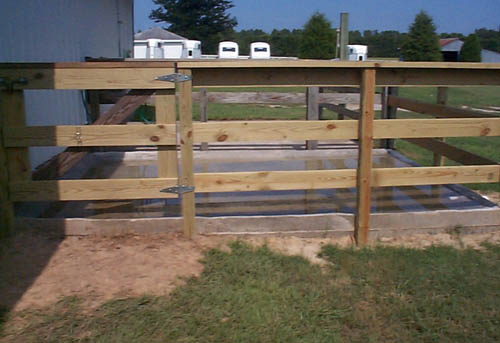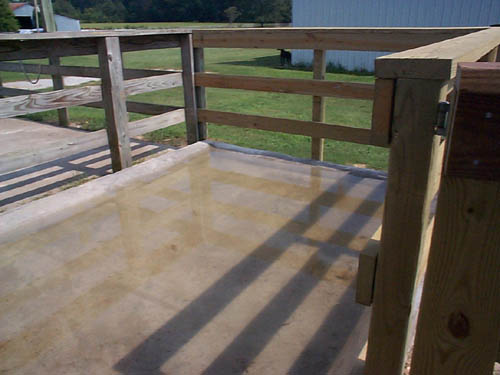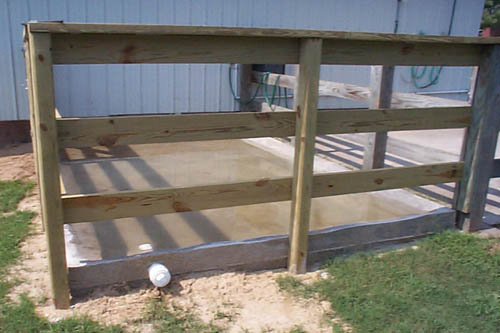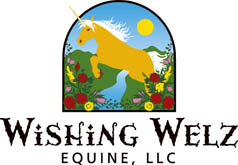


Soaking of the Hooves:
The Importance of Daily Exposure to Water
by Yvonne Welz ©2006
#1 Reason to soak your horse's hooves: Dryness causes contraction.
Excerpt from The Hoofcare Specialist's Handbook: Hoof Orthopedics and Holistic Lameness Rehabilitation, by Hiltrud Strasser, DVM & Sabine Kells:
"Insufficient exposure of the hoof to water is, at any age, a main cause or contributing factor for contraction.
"In the hoof, the horn containing the most water (frog, bulb, white line, periople) dries out the fastest and easiest. If the white line dries out, it loses volume, and as such shrinks, leaving open spaces where the corium lamellae used to be. Wall and sole connective horn likewise dry out quickly and shrink. This can be easily observed on a "slice" of hoof trimmed off with nippers: within a matter of hours to days, the horn will shrink to half its size as it dries out.
"Prevention of Contraction Due to Lack of Water: Daily immersion of the hooves in water past the coronet for at least 15 minutes (during the "dry" seasons, which includes winter with below-zero temperatures). Ideally, provide the horse with a natural water source, where it will immerse its own hooves when drinking every day."
However, climate is a huge factor. You may not get good results from soaking in an arid climate. Note from James & Yvonne Welz: We live in some of the driest area in the country, Phoenix, Arizona. James found that many of his client's horse's hooves healed in direct proportion to the amount of soaking they receive. The horses that received minimal soaking remained contracted longer, and tend to have more soreness and other issues. They were also extremely difficult to trim, and the quality of the horn remained poor, with a hard but brittle quality. The owners that soak religiously often had the quickest and greatest success. The horn quality changed to a pliable, elastic horn that was extremely hard and tough, yet easier to trim. It is as though this horn were more "alive" than that of unsoaked hooves. At the same time, these horses usually have feet that quickly decontract, and they are able to exercise over rocks, unbooted, much sooner. In the beginning of rehab of hooves, it seems that soaking is often very helpful as you attempt to decontract the hooves.
However, not all horses responded well to soaking long term - in some cases
it caused the hooves to deteriorate over time. Often soaking even created drier
hooves than not soaking. This was very confusing, as we tried to sort out what
worked and what didn't work. We found that, in this desert climate, it is more
important to keep moisture inside the hoof than it is to try and force
it into the hoof. A water-wet hoof will quickly evaporate and often take intregral
hoof moisture with it. The horses with the most problems were ones with a free-choice
water hole - the constant wet-dry situation caused major problems! Short, frequent
soaks are not a good idea in a dry climate - plan for infrequent, longer soaks
in water. Many people opt for a little overflow or mud around the water trough,
seal the outer wall with a dressing or sealant occasionally, and the horses
do just fine.
How often to soak? Ideally, every single day, for every horse in a wet climate. In a dry climate, longer soaks a few times per week will be more beneficial, and please use something (yes, like a hoof dressing - we recommend Hoof Alive) to seal that water in. Soak in plain water over the coronet band.
How long to soak? It really depends...If you are soaking to soften the hooves before trimming, you may have to soak for much longer than 10-15 minutes - in a dry climate, it may even take overnight soaking in hoof boots to soften the hooves enough! You will just have to experiment.
If you are soaking the hooves to help eliminate contraction, follow the advice of your hoofcare professional. There may even be periods of overnight or continuous soaking, initially, to achieve a certain effect.
If you are soaking just to rehydrate the hoof and white line, and to maintain
a healthy foot, you can soak for just 10-15 minutes per day in wet climates
(like Germany). However, in dry, desert climates (and severely dry seasons
in wet climates): the evaporation of water from the hoof capsule can
weaken the hoof wall and cause hairline cracks. Hoof horn is weakened when moisture
is wicked out quickly. The solution for desert climates is to soak for longer
periods (such as an hour or two) a couple times per week, than apply a hoof
dressing to seal the moisture into the hoof and prevent that rapid evaporation.
Keep in mind that every climate zone is going to create different challenges for your soaking regimine. Also, different seasons (and rainfall quantities) will make your soaking needs change. Horses kept on grass have moister feet, in general, than those kept on dirt. But no matter what your area is like, you need to make sure those hooves have enough moisture to keep them from contracting, and to keep the white line tight and healthy. And if you are starting out with contracted hooves (like most!) then water is one of the most important tools you have to change your horse's hooves back to healthy ones.
"Foot Spa"
Photos Below provided by Claudia Garner:
"I have a soaking chart in my barn, every horse that has
been in the water for 15 - 20 minutes (this is hot and humid South Carolina)
gets a check mark, every day. It makes the biggest difference in the trimming.
For a while we didn't do it as religiously and I could not get a hoofknife through
the hoof anymore (despite of my husband's best efforts to keep the knoves razorsharp
with a benchgrinder and muslin wheel). I have attached the pics of our "footspa".
It did cost about $ 500.00 in material to build. It has a drain and gets cleaned
almost daily. It was well worth the sweat to build, the money spent. Our horses
have a very good horn quality." -- Claudia, hhdressage@sc.rr.com
Horrell Hill Dressage and Trailer Sales Center
http://www.horrellhilldressage.com



©2006 by The Horse's Hoof. All rights reserved. No part of these publications may be reproduced by any means whatsoever without the written permission of the publisher and/or authors. The information contained within these articles is intended for educational purposes only, and not for diagnosing or medicinally prescribing in any way. Readers are cautioned to seek expert advice from a qualified health professional before pursuing any form of treatment on their animals. Opinions expressed herein are those of the authors and do not necessarily reflect those of the publisher.
The Horse's Hoof Website
Home - About Us -
Articles - Barefoot
Performance - Barefoot Stories - Hoof
Gallery - Natural
Horse Care - EPSM
- Events - Trimmers
- Experts -
Friends - Classified
- Resources
- News - Links
- Strasser
Hoofcare Links
To go shopping or subscribe to our magazine, please click here: The
Horse's Hoof Store
If you don't see a column to the left: To view the frames version of this site, please click here: TheHorsesHoof.com
The Horse's Hoof is a division of:

The Horse's Hoof
P.O. Box 1969
Queen Creek, AZ 85142
Phone (623) 935-1823
Message Phone: 1-623-935-1823
(Leave a message anytime.)
Email: editor @ TheHorsesHoof.com (delete spaces)